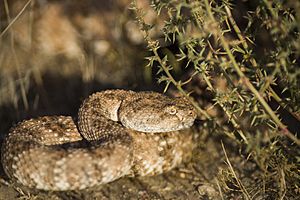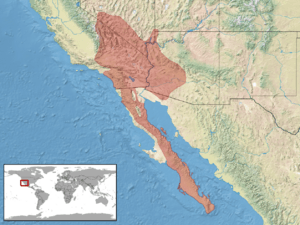Crotalus mitchellii facts for kids
Quick facts for kids Crotalus mitchellii |
|
|---|---|
 |
|
| Conservation status | |
| Scientific classification | |
| Genus: |
Crotalus
|
| Species: |
mitchellii
|
 |
|
| Synonyms | |
|
|
The speckled rattlesnake (scientific name: Crotalus mitchellii) is a type of venomous pit viper found in the Southwestern United States and northern Mexico. It is also known as Mitchell's rattlesnake or the white rattlesnake.
This snake was named after Silas Weir Mitchell, an American doctor who studied snake venoms. There are five different types, or subspecies, of the speckled rattlesnake.
Contents
About the Speckled Rattlesnake
Most speckled rattlesnakes are about 100 cm (39 in) (39 inches) long, including their tail. Some large males can grow up to 90 and 100 cm (35 and 39 in) (35 to 39 inches).
However, snakes on Isla Ángel de la Guarda can be much bigger. The longest one ever found there was 136.7 cm (53.8 in) (53.8 inches) long. On the other hand, snakes on El Muerto Island are quite small, reaching a maximum length of only 63.7 cm (25.1 in) (25 inches).
Where They Live
The speckled rattlesnake lives in the southwestern parts of the United States and northwestern Mexico.
In the US, you can find them in:
- East-central and southern California
- Southwestern Nevada
- Extreme southwestern Utah
- Western Arizona
In Mexico, they live in most of Baja California, including Baja California Sur. They also live on many islands in the Gulf of California. These islands include Angel de la Guarda, Carmen, Cerralvo, El Muerto, Espíritu Santo, Monserrate, Piojo, Salsipuedes, and San José. They are also found on Santa Margarita Island, off the Pacific coast of Baja California Sur.
The first speckled rattlesnake found and described by scientists came from Cabo San Lucas in Baja California Sur, Mexico.
Different Types of Speckled Rattlesnakes
Scientists recognize different types of speckled rattlesnakes, called subspecies. Here are a few:
| Subspecies | Named by | Common name | Where it lives |
|---|---|---|---|
| C. m. mitchellii | (Cope, 1861) | San Lucan speckled rattlesnake | Mexico, in Baja California Sur and on the islands of Santa Margarita, Cerralvo, Espíritu Santo, San José, Monserrate, and Carmen |
| C. m. muertensis | Klauber, 1949 | El Muerto Island speckled rattlesnake | Mexico, on the island of El Muerto |
Scientists sometimes discuss if these different types should be considered separate species or just subspecies. This is because they can have different body sizes or other unique features.
How They Are Protected
The main type of speckled rattlesnake (C. m. mitchellii) is listed as "Least Concern" on the IUCN Red List of Threatened Species. This means that, for now, there are plenty of these snakes, and their numbers seem to be stable. They are not currently at high risk of disappearing.
See also
 In Spanish: Cascabel de lentes para niños
In Spanish: Cascabel de lentes para niños


